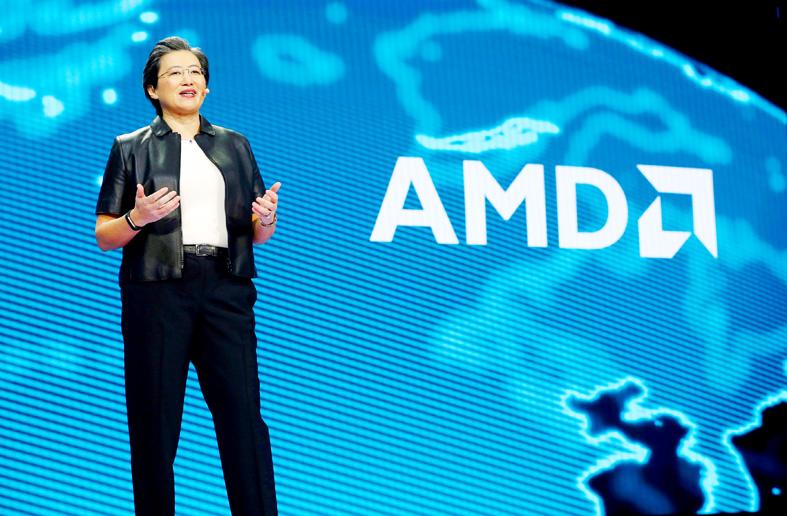Advanced Micro Devices Inc (AMD) CEO Lisa Su (蘇姿丰) spent her first six years at the helm turning around the troubled chipmaker. She slashed debt, and oversaw products that launched on time and performed as advertised.
Now she is moving beyond cleanup to challenge Intel Corp for the lead in computer chips.
The 51-year-old engineer — among the few female CEOs in technology — on Tuesday unveiled a US$35 billion all-stock acquisition of Xilinx Inc, one of the largest chip deals ever.

Photo: Reuters
In interviews and conference calls, Su said that there are few limits to her ambition.
“We have an even bigger place in the industry over the next five years than we’ve had in the last five,” she said.
Since taking over in 2014, Su has erased AMD’s reputation as an accident-prone supplier of cheap processors struggling to survive in Intel’s shadow — something her predecessors failed to do.
Buying Xilinx, a maker of programmable silicon, would take AMD into new areas such as automotive and communications networking, while bolstering its offerings in the lucrative market for cloud data center components, analysts said.
If the transaction closes next year as planned, the company’s annual research-and-development budget would jump to more than US$2.7 billion, they added.
That is still small compared with Intel’s budget, but it is a crucial ingredient if AMD is to seriously challenge the industry’s leaders.
Born in Taiwan, Su graduated from the Bronx High School of Science in New York City and got her doctorate from the Massachusetts Institute of Technology. She worked at companies including Texas Instruments Inc and International Business Machines Corp, and in 2012 arrived at AMD as a senior vice president.
An early success was getting AMD chips in the dominant gaming consoles, Microsoft Corp’s Xbox One and Sony Corp’s PlayStation. Most of her progress has come from a methodical focus on meeting customer demands — a stark contrast to former AMD CEOs who were known for splashy product launches that often did not deliver.
While she has been involved in chip industry innovation, Su dislikes portrayals of her as a lab-bound technical genius, describing herself as an OK engineer, and saying that one of her main skills is the ability to understand engineers and help them make the best high-level decisions, not do the work for them.
In her usual practical fashion, she presented the Xilinx deal to investors as a transaction that would improve AMD’s finances first and then transition the combined company to future technical leadership.
“I haven’t talked a lot about M&A [mergers and acquisitions] because I didn’t think there was a need to do M&A for M&A’s sake,” she said. “This is about what’s the next step for AMD and Xilinx is the best franchise in the industry.”
Su wants her company to be more than just another supplier of components. She sees Xilinx helping AMD set the industry’s agenda by defining new technology, something that has mostly been the preserve of Intel in computing for half a century.
Getting to this position has not been easy. When Su took the top job, she was AMD’s fourth CEO in a decade. The company had lost money in six of those 10 years as products either launched late, performed below expectations or had to be fixed later.
One of her biggest decisions in 2018 has helped Su keep her promises and set the stage for AMD’s next chapter. The company outsourced production of its best chips to Taiwan Semiconductor Manufacturing Co (TSMC, 台積電). Soon after, TSMC overtook Intel in production technology. Now AMD’s processors are often as capable as Intel’s — sometimes better. When she announced the Xilinx agreement, Su was careful to point out that her acquisition target also relies on TSMC’s production prowess.
Intel is going through an unprecedented series of stumbles with its once peerless manufacturing. It has only just started shipping large numbers of 10-nanometer chips, more than three years late. AMD and its customers are already enjoying the benefits — price, performance and power efficiency — of more advanced 7-nanometer manufacturing.
That type of technical leadership helped persuade Xilinx CEO Victor Peng (彭明博) to join Su.
“We had a great path as a standalone company,” said Peng, who is to become AMD president and continue to run the Xilinx business. “We looked at the landscape and we thought about this carefully. This is about choosing to be part of an even greater company — which is AMD.”

CHIP RACE: Three years of overbroad export controls drove foreign competitors to pursue their own AI chips, and ‘cost US taxpayers billions of dollars,’ Nvidia said China has figured out the US strategy for allowing it to buy Nvidia Corp’s H200s and is rejecting the artificial intelligence (AI) chip in favor of domestically developed semiconductors, White House AI adviser David Sacks said, citing news reports. US President Donald Trump on Monday said that he would allow shipments of Nvidia’s H200 chips to China, part of an administration effort backed by Sacks to challenge Chinese tech champions such as Huawei Technologies Co (華為) by bringing US competition to their home market. On Friday, Sacks signaled that he was uncertain about whether that approach would work. “They’re rejecting our chips,” Sacks

NATIONAL SECURITY: Intel’s testing of ACM tools despite US government control ‘highlights egregious gaps in US technology protection policies,’ a former official said Chipmaker Intel Corp has tested chipmaking tools this year from a toolmaker with deep roots in China and two overseas units that were targeted by US sanctions, according to two sources with direct knowledge of the matter. Intel, which fended off calls for its CEO’s resignation from US President Donald Trump in August over his alleged ties to China, got the tools from ACM Research Inc, a Fremont, California-based producer of chipmaking equipment. Two of ACM’s units, based in Shanghai and South Korea, were among a number of firms barred last year from receiving US technology over claims they have

It is challenging to build infrastructure in much of Europe. Constrained budgets and polarized politics tend to undermine long-term projects, forcing officials to react to emergencies rather than plan for the future. Not in Austria. Today, the country is to officially open its Koralmbahn tunnel, the 5.9 billion euro (US$6.9 billion) centerpiece of a groundbreaking new railway that will eventually run from Poland’s Baltic coast to the Adriatic Sea, transforming travel within Austria and positioning the Alpine nation at the forefront of logistics in Europe. “It is Austria’s biggest socio-economic experiment in over a century,” said Eric Kirschner, an economist at Graz-based Joanneum

BUBBLE? Only a handful of companies are seeing rapid revenue growth and higher valuations, and it is not enough to call the AI trend a transformation, an analyst said Artificial intelligence (AI) is entering a more challenging phase next year as companies move beyond experimentation and begin demanding clear financial returns from a technology that has delivered big gains to only a small group of early adopters, PricewaterhouseCoopers (PwC) Taiwan said yesterday. Most organizations have been able to justify AI investments through cost recovery or modest efficiency gains, but few have achieved meaningful revenue growth or long-term competitive advantage, the consultancy said in its 2026 AI Business Predictions report. This growing performance gap is forcing executives to reconsider how AI is deployed across their organizations, it said. “Many companies